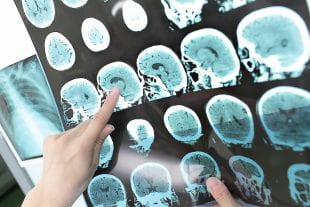Rice University
Office of Public Affairs
News & Media Relations
EXPERT ALERT
Jeff Falk
612-964-7236
jfalk@rice.edu
Amy McCaig
217-417-2901
amym@rice.edu
Analyzing patients shortly after stroke can help link brain regions to speech functions
HOUSTON – (March 23, 2020) – New research from Rice University and Baylor College of Medicine shows analyzing the brains of stroke victims just days after the stroke allows researchers to link various speech functions to different parts of the brain, an important breakthrough that may lead to better treatment and recovery.
The study, “Dissociation between frontal and temporal-parietal contributions to connected speech in acute stroke” will appear in an upcoming edition of the journal Brain.
Study co-author Randi Martin, the Elma W. Schneider Professor of Psychology at Rice, worked with a team of researchers led by Tatiana Schnur, associate professor of neurosurgery and neuroscience at the Baylor College of Medicine, to evaluate the spontaneous language production of 65 stroke patients by using storytelling. For the experiment, the patients were read the story of Cinderella and were then asked to retell it.
The researchers used a well-established process to score the patients — the Quantitative Production Analysis method— and relied on 13 different measures for evaluation, including words per minute, types of words, and sentence length and formation. They found that by evaluating patients between one and 13 days post-stroke, they were able to identify how different and critical components related to language production linked up with different regions of the brain. The researchers used cutting-edge techniques to relate the brain areas damaged in each individual to the degree of their impairment on these language-production measures. Specifically, they found that retrieving words and putting them into increasingly complex sentences relied on the left temporal and parietal lobes, while producing grammatical aspects of sentences relied on the left frontal lobe.
Martin noted there are only a few other studies that have looked at stroke patients in the acute stage, but those focused on ability to produce single words rather than providing a detailed analysis of language production. The majority of studies, she said, look at stroke patients in the chronic stage of recovery, which is at least six months after the stroke. At that time, considerable reorganization of language function in the brain may have occurred. Also, studying individuals at the acute stage allows for studying those with smaller areas of damage, she said. Those with small lesions are likely to recover and thus not included in studies of chronic stroke, and examining these people allows for a more precise mapping between areas damaged and language abilities.
“Many patients in the chronic stage of stroke have significantly worse brain damage than acute patients and have plateaued with their recovery,” she said. “Their brains cannot be evaluated in the same way as acute stroke patients.”
Future work will look at these same individuals at different stages during their first year of the recovery process. One important issue will be to determine what areas of brain damage and what language abilities will predict performance a year after stroke.
Martin hopes this work will help better understand how different brain regions recover from stroke. She expects the work will be useful in the design of treatment options for stroke patients, including early interventions that may boost long-term recovery.
The study’s lead author was Junhua Ding from Baylor College of Medicine. Other co-authors were Cris Hamilton from the University of Texas at Austin and corresponding author Tatiana Schnur from Baylor College of Medicine.
The study was funded by an award to Baylor College of Medicine from the National Institute on Deafness and Other Communication Disorders and an award to Rice from the Moody Endowment.
-30-
For more information or to schedule an interview, contact Amy McCaig, senior media relations specialist at Rice, at 217-417-2901 or amym@rice.edu.
This news release can be found online at news.rice.edu.
Follow Rice News and Media Relations on Twitter @RiceUNews.
Related materials:
Randi Martin bio: https://psychology.rice.edu/randi-martin
Photo link: https://news2.rice.edu/files/2020/03/22674485_l.jpg
Photo credit: 123rf.com
Located on a 300-acre forested campus in Houston, Rice University is consistently ranked among the nation’s top 20 universities by U.S. News & World Report. Rice has highly respected schools of Architecture, Business, Continuing Studies, Engineering, Humanities, Music, Natural Sciences and Social Sciences and is home to the Baker Institute for Public Policy. With 3,962 undergraduates and 3,027 graduate students, Rice’s undergraduate student-to-faculty ratio is just under 6-to-1. Its residential college system builds close-knit communities and lifelong friendships, just one reason why Rice is ranked No. 1 for lots of race/class interaction and No. 4 for quality of life by the Princeton Review. Rice is also rated as a best value among private universities by Kiplinger’s Personal Finance.


